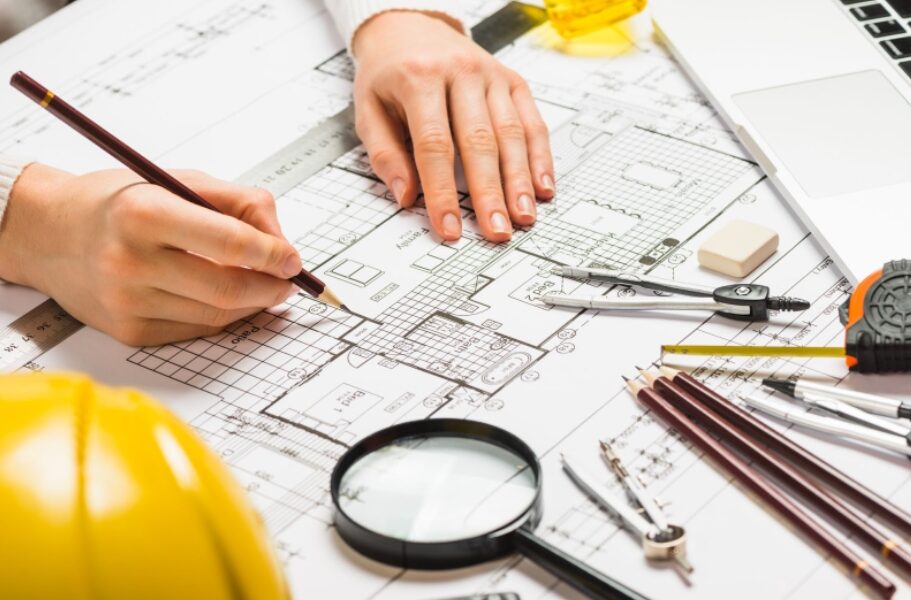What to Expect During the Design-Build Process: A Step-by-Step Guide

The design-build construction approach has become a popular choice for building projects due to its streamlined process, collaborative nature, and ability to deliver projects efficiently. Unlike traditional construction methods, where design and construction are handled separately, the design-build process integrates both phases under a single entity, the design-build contractor.
This guide will walk you through the step-by-step journey of the design-build process, offering insights into what to expect, how it works, and why it’s an effective choice for many construction projects. By understanding each phase, you’ll gain clarity on how design and construction services come together to create successful outcomes.
Understanding the Design-Build Approach
The design-build construction method is a project delivery system where one team, led by a design-build contractor, is responsible for both the design and construction phases of a project. This single-point responsibility contrasts with traditional construction project delivery methods, such as design-bid-build, where the owner contracts separately with a designer and a builder. The integrated approach fosters collaboration, reduces miscommunication, and often results in faster project completion and cost savings.
The history of this approach also provides context for its growing popularity in the design and construction industry. For a deeper dive, see The History of Design-Build.
The design-build process is a structured yet flexible framework that guides a project from concept to completion. Below, we outline the key steps involved, offering a clear picture of what to expect at each stage.
Step 1: Project Initiation and Owner Engagement
The design-build process begins with the project owner defining their goals, needs, and budget. Whether it’s a commercial building, educational facility, or infrastructure project, this initial phase sets the foundation for success. The owner selects a design-build contractor to lead the project, often based on qualifications, experience, and a proven track record in delivering similar construction projects.
During this phase, the owner and contractor collaborate to establish project objectives, including scope, timeline, and budget. The design-build contractor may conduct feasibility studies, site assessments, and preliminary cost estimates to ensure alignment with the owner’s vision. This collaborative start minimizes risks and ensures all parties are on the same page before moving forward.
Step 2: Signing the Design-Build Contract
Once the design-build contractor is selected, the next step is formalizing the partnership through a design-build contract. This contract outlines the responsibilities, deliverables, and expectations for both the contractor and the owner. Unlike traditional contracts, which separate design and construction, the design-build contract covers both phases under a single agreement, streamlining communication and accountability.
The contract typically includes details such as project scope, budget, timeline, and performance criteria. It may also address contingencies, such as unforeseen site conditions or changes in project requirements. A well-crafted design-build contract ensures clarity and protects all parties throughout the construction process.
Step 3: Conceptual Design and Planning
With the contract in place, the design-build contractor begins the conceptual design phase. This stage involves architects, engineers, and other professionals working together to create initial design concepts that align with the owner’s goals. The collaborative nature of design-build construction allows for real-time input from both the design and construction teams, ensuring that designs are practical and cost-effective.
During this phase, the team develops preliminary drawings, site plans, and cost estimates. They also consider factors such as sustainability, building codes, and site-specific challenges. The owner is actively involved, providing feedback to refine the design. This iterative process helps avoid costly redesigns later in the construction process.
Step 4: Detailed Design Development
Once the conceptual design is approved, the design-build contractor moves into detailed design development. This phase involves creating comprehensive architectural and engineering plans, including detailed drawings, specifications, and material selections. The integration of design and construction services ensures that the design is optimized for constructability, minimizing potential issues during the building phase.
The design-build contractor may use advanced tools like Building Information Modeling (BIM) to create 3D models of the project. These models help visualize the final structure, identify potential conflicts, and improve coordination between disciplines. The owner continues to provide input, ensuring the design aligns with their vision while staying within budget and schedule constraints.
Step 5: Pre-Construction and Permitting
Before construction begins, the design-build contractor handles pre-construction activities, including securing permits, conducting site surveys, and finalizing budgets. This phase is critical for ensuring compliance with local regulations and preparing the site for construction. The design and construction industry relies on thorough pre-construction planning to avoid delays and unexpected costs.
The contractor also coordinates with subcontractors, suppliers, and other stakeholders to ensure all resources are in place. By addressing logistical details early, the design-build process minimizes disruptions and keeps the project on track.
Step 6: Construction Phase
The construction phase is where the vision comes to life. The design-build contractor oversees all aspects of the construction process, from site preparation to final finishes. Because the design and construction teams work under the same leadership, issues can be resolved quickly, and changes can be implemented without significant delays.
The design-build construction approach allows for overlapping design and construction activities, known as fast-tracking. For example, construction may begin on certain elements, such as the foundation, while the design team finalizes details for later phases. This flexibility can significantly reduce the overall project timeline, making it ideal for time-sensitive building projects.
Throughout this phase, the design-build contractor provides regular updates to the owner, ensuring transparency and alignment. Quality control measures, safety protocols, and budget tracking are also prioritized to deliver a high-quality project.
Step 7: Project Closeout and Handover
Once construction is complete, the design-build contractor conducts a thorough closeout process. This includes final inspections, testing systems (such as HVAC or electrical), and addressing any punch-list items. The contractor ensures that the project meets all design specifications, building codes, and owner expectations.
The owner receives all necessary documentation, including warranties, as-built drawings, and maintenance manuals. A successful handover marks the completion of the design-build process, with the owner ready to occupy or operate the new facility.
Step 8: Post-Construction Support
The design-build process doesn’t always end with handover. Many design-build contractors offer post-construction support, such as maintenance services, performance evaluations, or assistance with facility operations. This ongoing relationship ensures the project continues to meet the owner’s needs long after completion.
Benefits of the Design-Build Process
The design-build construction method offers several advantages over traditional construction project delivery methods. These include:
- Single-Point Responsibility: The design-build contractor is accountable for both design and construction, reducing the owner’s need to manage multiple contracts.
- Improved Collaboration: The integration of design and construction services fosters teamwork, minimizing miscommunication and conflicts.
- Cost and Time Savings: By overlapping design and construction phases, the design-build process can reduce costs and accelerate project timelines.
- Enhanced Quality: The collaborative approach ensures that designs are practical and buildable, resulting in higher-quality outcomes.
- Flexibility: The design-build contractor can adapt to changes or unforeseen challenges more effectively than in traditional methods.
For a detailed exploration of these benefits, refer to this guide: 10 Reasons Why the Design-Build Delivery Method Works.
Challenges to Consider
While the design-build process offers many benefits, it’s not without challenges. Owners must carefully select a design-build contractor with the expertise and resources to handle their specific project. Clear communication and a well-defined design-build contract are essential to avoid scope creep or misunderstandings. Additionally, some owners may feel they have less control over the design process compared to traditional methods, as the contractor takes on a more significant leadership role.
To mitigate these challenges, owners should conduct thorough due diligence when selecting a contractor and maintain open communication throughout the project. Understanding the history of the design and construction industry can also provide context for choosing the right approach.
Why Choose Design-Build for Your Project?
The design-build construction method is ideal for owners seeking a streamlined, collaborative, and efficient approach to building projects. Whether you’re constructing a school, office, or industrial facility, the design-build process offers a cohesive framework that integrates design and construction services under one roof. By working with a qualified design-build contractor, you can achieve your project goals while minimizing risks and maximizing value.
Conclusion
The design-build process is a proven method for delivering successful construction projects. From project initiation to post-construction support, this approach offers a seamless, collaborative experience that saves time, reduces costs, and ensures quality. By understanding each step and partnering with an experienced design-build contractor, owners can navigate the construction process with confidence and achieve their vision.
Whether you’re new to design-build construction or a seasoned project owner, this guide provides a roadmap for what to expect and how to succeed.





